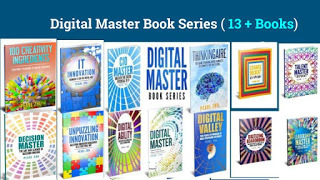Pearl Zhu's Blog, page 1252
February 9, 2017
The Weekly Insight of the “Future of CIO” 2/10/ 2017
 The “Future of CIO” Blog has reached 1.7 million page views with 3500+ blog posting in 59+ different categories of leadership, management, strategy, digitalization, change/talent, etc. The content richness is not for its own sake, but to convey the vision and share the wisdom. Here is the weekly insight about digital leadership, IT Management, and Talent Management.
The “Future of CIO” Blog has reached 1.7 million page views with 3500+ blog posting in 59+ different categories of leadership, management, strategy, digitalization, change/talent, etc. The content richness is not for its own sake, but to convey the vision and share the wisdom. Here is the weekly insight about digital leadership, IT Management, and Talent Management.
The Weekly Insight of the “Future of CIO” 2/10/2017Which qualities, technical as well as leadership skills, are true differentiators to become a unique CIO: IT plays a more critical role in driving changes and leading digital transformation, thus, the bar of CIO leadership is also raised for adapting to the faster pace of changes and continuous digital disruptions. It is not sufficient to be just a tactical manager to keep the lights on, in fact, today’s IT leaders should have the multi-faceted personas, multilayered professional capabilities, and the multitude of leadership qualities and skill set in order to lead seamlessly. But more specifically, which qualities, technical as well as leadership skills, are true differentiators to become a unique CIO.
The New Book “Decision Master” Thoughts and Quotes Collection III: Decision Masters refer to the digital leaders or professionals who can leverage multidimensional thought processes, information and intuition, take a step-wise scenario for making effective decisions consistently. Decision Masters also refer to the businesses or organizations that follow a set of well-defined principles, leverage fine-tuned decision processes, efficient information management system, decision frameworks, tools, and metrics to enable people across the organization making effective decisions collaboratively.
The Monthly Insight of the Board Room: A Digital Savvy Boardroom Feb. 2017: Modern corporate boards play significant roles in guiding businesses toward the right direction and achieve expected business results. Due to the “VUCA” characteristics -Complexity, Uncertainty, Ambiguity and Velocity of the Digital Era, the directorship in any organization must have the agility to adapt to changes and build abilities to advise, inspire and motivate a group of people toward accomplishing shared visions and goals.
 CIOs as Chief Innovation Officer: Where are the Innovation Hot Spots? Digital is the age of innovation. And innovation is what leads to differentiation. Different organizations have their own “innovation strength.” There are many ways to differentiate and, therefore, there are many ways to pursue innovation. The innovation-generating organization depends more heavily on its technological knowledge and market capabilities to develop and commercialize innovations; the innovation-adopting organization relies more on its managerial and organizational capabilities to select and assimilate innovations. IT organizations strive to become the innovation hub of the businesses, CIOs as Chief Innovation Officer: Where are the innovation hot spots and can you identify them?
CIOs as Chief Innovation Officer: Where are the Innovation Hot Spots? Digital is the age of innovation. And innovation is what leads to differentiation. Different organizations have their own “innovation strength.” There are many ways to differentiate and, therefore, there are many ways to pursue innovation. The innovation-generating organization depends more heavily on its technological knowledge and market capabilities to develop and commercialize innovations; the innovation-adopting organization relies more on its managerial and organizational capabilities to select and assimilate innovations. IT organizations strive to become the innovation hub of the businesses, CIOs as Chief Innovation Officer: Where are the innovation hot spots and can you identify them?
How to close the vision gaps?The best vision is insight, the most-wanted vision is foresight, Being a visionary is a character or perspective. Leadership is about the future and change, innovation and progress. Leadership vision is not just about zooming in but also stepping into the future proactively. The vision thing is, in fact, the precious leadership trait to bridge the industrial age and the digital era; the local and global, the business reality and the future of the organization. A clear vision will enable digital leaders today to lead businesses toward the uncharted water or blurred digital territories confidently. So, how to close the vision gaps and make a leap of digital transformation?
Blogging is not about writing, but about thinking and innovating the new ideas; it’s not just about WHAT to say, but about WHY to say, and HOW to say it. It reflects the color and shade of your thought patterns, and it indicates the peaks and curves of your thinking waves. Unlike pure entertainment, quality and professional content takes time for digesting, contemplation and engaging, and therefore, it takes the time to attract the "hungry minds" and the "deep souls." It’s the journey to amplify diverse voices and deepen digital footprints, and it's the way to harness your innovative spirit.
Follow us at: @Pearl_Zhu
Published on February 09, 2017 23:02
Bridging the Gaps of Accountability
 Digital transformation is all about shaping highly performing and highly innovative organizations. Lack of accountability is often one of the biggest obstacles to getting things done, or cause change inertia. Because people don’t feel “safe,” or run away from accountability because they had a personal experience or they have observed others being treated poorly or unfairly when being held accountable for results. So, how to bridge the accountability gaps and improve the business manageability to encourage responsible communication, decision-making, and action, with the intention to build on morale and real productivity? In detail, how do you drive workforce performance, whilst bridging gaps, and generating accountability for that performance?Accountability needs a safe environment: That starts with leaders at the top. Behaving accountable is the result of a culture with values that need to be organized and nurtured. It is not uncommon to confuse accountability with blame. They are actually opposites. Shared accountability or collective accountability involves shared ownership, empathetic communication, the true measure of accountability is about resilience: It is determined not by whether someone or a team makes a mistake or not, but on how quickly they can recover so that customers, teammates, and others aren't negatively affected by the breakdown. You will be held accountable" is on the face of it, not a bad thing, you have the freedom to do whatever needs to be done, and the responsibility to ensure you do your best to bring about a good outcome. If "accountability" has bad connotations, it is because there is blame attached and other consequences. The leaders and managers should be more interested in finding "causes," not interested in assigning blame.Behaving in a trustworthy manner is crucial: Using the forces of respect for every employee, versus fear and punishment. Belief in the high value of both team and each team member, profits, and performance. This is the long view and takes some courage and faith to develop, but it worths the effort, and it ultimately releases the highest potential of each employee. Allow for personal traits that will vary both among the person who delegates and the person delegated to. There are also some structural issues with accountability. If one is to hold another accountable (peer or subordinate) for achieving some result, there is a set of conditions that must be fulfilled in advance on the "receiver" side. Among them, that person must be reasonably known to possess the skill/talent needed; she or he is provided with the tools and resources necessary to succeed.
Digital transformation is all about shaping highly performing and highly innovative organizations. Lack of accountability is often one of the biggest obstacles to getting things done, or cause change inertia. Because people don’t feel “safe,” or run away from accountability because they had a personal experience or they have observed others being treated poorly or unfairly when being held accountable for results. So, how to bridge the accountability gaps and improve the business manageability to encourage responsible communication, decision-making, and action, with the intention to build on morale and real productivity? In detail, how do you drive workforce performance, whilst bridging gaps, and generating accountability for that performance?Accountability needs a safe environment: That starts with leaders at the top. Behaving accountable is the result of a culture with values that need to be organized and nurtured. It is not uncommon to confuse accountability with blame. They are actually opposites. Shared accountability or collective accountability involves shared ownership, empathetic communication, the true measure of accountability is about resilience: It is determined not by whether someone or a team makes a mistake or not, but on how quickly they can recover so that customers, teammates, and others aren't negatively affected by the breakdown. You will be held accountable" is on the face of it, not a bad thing, you have the freedom to do whatever needs to be done, and the responsibility to ensure you do your best to bring about a good outcome. If "accountability" has bad connotations, it is because there is blame attached and other consequences. The leaders and managers should be more interested in finding "causes," not interested in assigning blame.Behaving in a trustworthy manner is crucial: Using the forces of respect for every employee, versus fear and punishment. Belief in the high value of both team and each team member, profits, and performance. This is the long view and takes some courage and faith to develop, but it worths the effort, and it ultimately releases the highest potential of each employee. Allow for personal traits that will vary both among the person who delegates and the person delegated to. There are also some structural issues with accountability. If one is to hold another accountable (peer or subordinate) for achieving some result, there is a set of conditions that must be fulfilled in advance on the "receiver" side. Among them, that person must be reasonably known to possess the skill/talent needed; she or he is provided with the tools and resources necessary to succeed.
 Designing a performance management system that enforces accountability: A professional is responsible for his/her actions. He/she should be accountable to his/her company, to himself/herself or his/her conscience. It seems simple, but it has many different additional advantages encouraging knowledge transfer within the team, engagement and so on. One of the "obstacles" is not having the same rules for accountability apply everywhere. Accountability goes hand in hand with the delegation of authority or power. Accountability is a part of the personal integrity. If you ensure the individuals have the autonomy within their tasks or projects you will be able to address performance on an equal partnership base.Digital organizations are flatter, with an “every individual as a stakeholder” culture, it is imperative to close the accountability gap through improving cross-functional collaboration, open door listening, transparency ("we have a problem to solve together") and mutual sharing in successes, the performance accountability can be harnessed via motivating your employees to achieve high than expected result and build the culture of learning, trust, and professionalism.
Designing a performance management system that enforces accountability: A professional is responsible for his/her actions. He/she should be accountable to his/her company, to himself/herself or his/her conscience. It seems simple, but it has many different additional advantages encouraging knowledge transfer within the team, engagement and so on. One of the "obstacles" is not having the same rules for accountability apply everywhere. Accountability goes hand in hand with the delegation of authority or power. Accountability is a part of the personal integrity. If you ensure the individuals have the autonomy within their tasks or projects you will be able to address performance on an equal partnership base.Digital organizations are flatter, with an “every individual as a stakeholder” culture, it is imperative to close the accountability gap through improving cross-functional collaboration, open door listening, transparency ("we have a problem to solve together") and mutual sharing in successes, the performance accountability can be harnessed via motivating your employees to achieve high than expected result and build the culture of learning, trust, and professionalism. Follow us at: @Pearl_Zhu
Published on February 09, 2017 22:59
Monitor the Digital Pulse of Organizations
 The multidimensional digital transformation provides impressive advantages in terms of the speed of delivering solutions and adapting to changes. The effects of an increasingly digitalized world are now reaching into every corner of businesses and every aspect of organizations. Digital businesses nowadays are fast, always “on,” highly connected, interdependent, and ultra-competitive. Digital transformation is not a one-time project or a stand-alone initiative, it is a continuous journey to adapt to the new normal of the business world. As the business executive, how can you monitor the digital pulse of your company in order to lead changes steadfastly and manage the business effectively?
The multidimensional digital transformation provides impressive advantages in terms of the speed of delivering solutions and adapting to changes. The effects of an increasingly digitalized world are now reaching into every corner of businesses and every aspect of organizations. Digital businesses nowadays are fast, always “on,” highly connected, interdependent, and ultra-competitive. Digital transformation is not a one-time project or a stand-alone initiative, it is a continuous journey to adapt to the new normal of the business world. As the business executive, how can you monitor the digital pulse of your company in order to lead changes steadfastly and manage the business effectively?
Information management pulse: Digital is the age of information abundance, the business needs IT to provide better information to achieve improved profitability. Monitoring information management pulse is to ensure IT can deliver accurate, authentic and on-time information to the business for making right decisions at the right time. If information based business insight built is poor or not managed in a proper way, it may lead to wrong decisions and hence impact on the business survival. Metaphorically, organization’s information pulse is like the “heartbeat” of the business, it needs to run at the right pace to keep the enterprise body energetic and healthy. The management of IT goes beyond IT because often information has to flow across functionally with the business ecosystem in order to capture the real business insight in a comprehensive way. It takes organizational-scope support to manage business information life cycle. Through monitoring information pulse, the top leadership team can become more collaborative for taking responsibility of evaluating IT investment performance, breaking down silo thinking, in order to keep information flow, and thus, business flow and run a real-time smart organization.
Innovation pulse: Innovation is a production, adoption, assimilation, and exploitation of value-added novelty in the business. Digital is the age of innovation, it opens the new chapter of the playbook with the full spectrum of innovation management, such as incremental innovation, evolutionary innovation, breakthrough innovation; hard and soft innovations such as products/services/business model/management/culture innovation. Innovation becomes simply ”creating value by solving simple or complex problems.” Monitoring the innovation pulse of your organization is to help the leadership team make an objective assessment of the business’s innovation capability; and read the organization’s culture expression, with the goal to build the working environment which encourages creative thinking and experimenting. Some use Innovation quotients which integrate both numerical and qualitative information that relates to innovation success. Besides the hard numbers or numerical success indicators, it is important to bring more qualitative information that is crucial in understanding the health and well-being of the firm's innovation efforts. Always keep in mind, the goal of innovation assessment and measurement is to build innovation capacity and capability.
 Change pulse: Digital means the increasing speed of changes. Change is always happening around us at work and life. Organizations and their people learn through their interactions with the environment. They act, observe the consequences of their action, make inferences about those consequences, and draw implications for future action. Monitoring the change pulse of the business is to assess the business’s maturity traits such as adaptability, flexibility, resilience, responsiveness, agility, effectiveness, speed, etc. The changes delivered could be incremental, transitional (Improving on a process) or transformational, if it is fundamentally shifting the entire business model of an organization. There are significant deliverables that must be tied to all plans. The bigger the 'change' the more important to keep it on track and take these into account early rather than late. The change pulse of your organization is synchronous with the pace of digital transformation. Periodic assessments are necessary to track initiative-steps. You must show the 'progress' as you go along. The process is adaptively rational. There is the pitfall in monitoring changes. Perhaps the difficulty in measuring change management is that the very thing we are measuring is changing. There is an inherent oxymoron in the term change management. We want people to change, and manage or control at the same time. Change is not for its own sake. It’s very important for any high performing organization to get the best alignment and leverage the great human potential that exists or is needed to achieve great results and to tap into the passion of the people!
Change pulse: Digital means the increasing speed of changes. Change is always happening around us at work and life. Organizations and their people learn through their interactions with the environment. They act, observe the consequences of their action, make inferences about those consequences, and draw implications for future action. Monitoring the change pulse of the business is to assess the business’s maturity traits such as adaptability, flexibility, resilience, responsiveness, agility, effectiveness, speed, etc. The changes delivered could be incremental, transitional (Improving on a process) or transformational, if it is fundamentally shifting the entire business model of an organization. There are significant deliverables that must be tied to all plans. The bigger the 'change' the more important to keep it on track and take these into account early rather than late. The change pulse of your organization is synchronous with the pace of digital transformation. Periodic assessments are necessary to track initiative-steps. You must show the 'progress' as you go along. The process is adaptively rational. There is the pitfall in monitoring changes. Perhaps the difficulty in measuring change management is that the very thing we are measuring is changing. There is an inherent oxymoron in the term change management. We want people to change, and manage or control at the same time. Change is not for its own sake. It’s very important for any high performing organization to get the best alignment and leverage the great human potential that exists or is needed to achieve great results and to tap into the passion of the people!
Monitoring digital pulse is the necessary step from doing digital to going digital and being digital. Going digital takes multifaceted management disciplines and structural approach to drilling down the critical success factors that underpin each of the higher level performance dimension. It’s a core shift on how the business operates and how it can make a leap. Understand your digital pulse to drive business transformation steadfastly.
Follow us at: @Pearl_Zhu
Published on February 09, 2017 22:55
February 8, 2017
The Monthly “IT Innovation” Book Tuning Feb. 2017
Digital is the age of innovation. And innovation is what leads to differentiation.
 IT plays a significant role in managing information-knowledge-insight cycle and fostering innovation by leveraging disruptive technologies and enriched information flow. But more specifically, how can IT build differentiated capabilities to become an information power center and an innovation hub? The purpose of “IT innovation - Reinvent IT for the Digital Age” is to help business and IT leaders and digital professionals ride above the learning curve, reinvent IT as an innovation hub and game changer; reimagine IT as an innovation outlier; renovate a hybrid IT and digital organization; fine-tune IT as the digital whole brain of the organization; accelerate IT on the fast lane, rebuild IT as the business capability multiplier; empower IT as a digital change agent; and leverage the “alphabetic elements” to run a highly innovative IT organization for the digital age.
IT plays a significant role in managing information-knowledge-insight cycle and fostering innovation by leveraging disruptive technologies and enriched information flow. But more specifically, how can IT build differentiated capabilities to become an information power center and an innovation hub? The purpose of “IT innovation - Reinvent IT for the Digital Age” is to help business and IT leaders and digital professionals ride above the learning curve, reinvent IT as an innovation hub and game changer; reimagine IT as an innovation outlier; renovate a hybrid IT and digital organization; fine-tune IT as the digital whole brain of the organization; accelerate IT on the fast lane, rebuild IT as the business capability multiplier; empower IT as a digital change agent; and leverage the “alphabetic elements” to run a highly innovative IT organization for the digital age.
“IT Innovation” Book TuningWhere are the Innovation Hot Spots? Digital is the age of innovation. And innovation is what leads to differentiation. Different organizations have their own “innovation strength.” There are many ways to differentiate and, therefore, there are many ways to pursue innovation. The innovation-generating organization depends more heavily on its technological knowledge and market capabilities to develop and commercialize innovations; the innovation-adopting organization relies more on its managerial and organizational capabilities to select and assimilate innovations. IT organizations strive to become the innovation hub of the businesses, CIOs as Chief Innovation Officer: Where are the innovation hot spots and can you identify them?
Running IT as an Innovation Hub IT is omnipresent and permeated into every corner of the organization. Forward-looking organizations are also reinventing IT reputation from a cost center to a value creator, from a static support function to a dynamic change agent; and from inside-out operation driven to outside-in customer-centric. To put simply, how can IT build differentiated capabilities to become an information power center and an innovation engine.
Three Silo Effects to Stifle IT Innovation? Forward-looking organizations are reimagining the digital potential of IT and reinventing IT reputation from a cost center to an innovation engine. However, the majority of IT organizations still get stuck at the lower level of maturity, running as a siloed function. Despite the mountain of evidence pointing the detrimental effects of these silos, they still seem to be quite common in the organization. What are the root causes to silos? Are silos a mere product of organizational design? Or is their nature tied to human nature? What are silo effects which stifle innovation, and downgrade IT effectiveness and performance? What would be some ideas to assist in breaking down silos in an organization where they are present?
How does IT handle investigations of innovative business solutions? IT plays a critical role in building business competency. IT has itself transformed to creating a new competitive advantage via building new products, new services and delivering tailored business solutions. But many of today’s C-suites are unaware of what is technologically possible now or in the future. Digital is the age of options, it provides the opportunity to think the new way to do things, so it forces IT leaders to get really creative on how they architect and implement change, and how IT handles investigation of innovative business solutions, to change the business’s perception, reinvent its tarnished reputation and improve the overall business maturity.
 A set of Q&As (X) Dealing with IT Innovation Paradox Modern CIOs face many challenges, it is not sufficient to only keep the lights on. Regardless of which industry or the nature of organization you are in, being a digital leader will need to master the art of creating unique, differentiating value from piles of commoditized technologies and take advantage of the emergent digital trend as well; digital CIOs also have multiple personas, “Chief Innovation Officer,” “Chief Insight Officer,” “Chief Improvement Officer,” “Chief Information Officer,” and here, we discuss CIOs as “Chief Inquisitive Officer,” with a set of Q&As to lead digital transformation.
A set of Q&As (X) Dealing with IT Innovation Paradox Modern CIOs face many challenges, it is not sufficient to only keep the lights on. Regardless of which industry or the nature of organization you are in, being a digital leader will need to master the art of creating unique, differentiating value from piles of commoditized technologies and take advantage of the emergent digital trend as well; digital CIOs also have multiple personas, “Chief Innovation Officer,” “Chief Insight Officer,” “Chief Improvement Officer,” “Chief Information Officer,” and here, we discuss CIOs as “Chief Inquisitive Officer,” with a set of Q&As to lead digital transformation.
The “Future of CIO” Blog has reached 1.7 million page views with about 3500+ blog posting in 59+ different categories of leadership, management, strategy, digitalization, change/talent, etc. The content richness is not for its own sake, but to convey the vision and share the wisdom. Blogging is not about writing, but about thinking; it’s not just about WHAT to say, but about WHY to say, and HOW to say it. It reflects the color and shade of your thought patterns, and it indicates the peaks and curves of your thinking waves. Unlike pure entertainment, quality and professional content takes time for digesting, contemplation and engaging, and therefore, it takes the time to attract the "hungry minds" and the "deep souls." It’s the journey to amplify your voice, deepen your digital footprints, and match your way for human progression.
Follow us at: @Pearl_Zhu
 IT plays a significant role in managing information-knowledge-insight cycle and fostering innovation by leveraging disruptive technologies and enriched information flow. But more specifically, how can IT build differentiated capabilities to become an information power center and an innovation hub? The purpose of “IT innovation - Reinvent IT for the Digital Age” is to help business and IT leaders and digital professionals ride above the learning curve, reinvent IT as an innovation hub and game changer; reimagine IT as an innovation outlier; renovate a hybrid IT and digital organization; fine-tune IT as the digital whole brain of the organization; accelerate IT on the fast lane, rebuild IT as the business capability multiplier; empower IT as a digital change agent; and leverage the “alphabetic elements” to run a highly innovative IT organization for the digital age.
IT plays a significant role in managing information-knowledge-insight cycle and fostering innovation by leveraging disruptive technologies and enriched information flow. But more specifically, how can IT build differentiated capabilities to become an information power center and an innovation hub? The purpose of “IT innovation - Reinvent IT for the Digital Age” is to help business and IT leaders and digital professionals ride above the learning curve, reinvent IT as an innovation hub and game changer; reimagine IT as an innovation outlier; renovate a hybrid IT and digital organization; fine-tune IT as the digital whole brain of the organization; accelerate IT on the fast lane, rebuild IT as the business capability multiplier; empower IT as a digital change agent; and leverage the “alphabetic elements” to run a highly innovative IT organization for the digital age.
“IT Innovation” Book TuningWhere are the Innovation Hot Spots? Digital is the age of innovation. And innovation is what leads to differentiation. Different organizations have their own “innovation strength.” There are many ways to differentiate and, therefore, there are many ways to pursue innovation. The innovation-generating organization depends more heavily on its technological knowledge and market capabilities to develop and commercialize innovations; the innovation-adopting organization relies more on its managerial and organizational capabilities to select and assimilate innovations. IT organizations strive to become the innovation hub of the businesses, CIOs as Chief Innovation Officer: Where are the innovation hot spots and can you identify them?
Running IT as an Innovation Hub IT is omnipresent and permeated into every corner of the organization. Forward-looking organizations are also reinventing IT reputation from a cost center to a value creator, from a static support function to a dynamic change agent; and from inside-out operation driven to outside-in customer-centric. To put simply, how can IT build differentiated capabilities to become an information power center and an innovation engine.
Three Silo Effects to Stifle IT Innovation? Forward-looking organizations are reimagining the digital potential of IT and reinventing IT reputation from a cost center to an innovation engine. However, the majority of IT organizations still get stuck at the lower level of maturity, running as a siloed function. Despite the mountain of evidence pointing the detrimental effects of these silos, they still seem to be quite common in the organization. What are the root causes to silos? Are silos a mere product of organizational design? Or is their nature tied to human nature? What are silo effects which stifle innovation, and downgrade IT effectiveness and performance? What would be some ideas to assist in breaking down silos in an organization where they are present?
How does IT handle investigations of innovative business solutions? IT plays a critical role in building business competency. IT has itself transformed to creating a new competitive advantage via building new products, new services and delivering tailored business solutions. But many of today’s C-suites are unaware of what is technologically possible now or in the future. Digital is the age of options, it provides the opportunity to think the new way to do things, so it forces IT leaders to get really creative on how they architect and implement change, and how IT handles investigation of innovative business solutions, to change the business’s perception, reinvent its tarnished reputation and improve the overall business maturity.
 A set of Q&As (X) Dealing with IT Innovation Paradox Modern CIOs face many challenges, it is not sufficient to only keep the lights on. Regardless of which industry or the nature of organization you are in, being a digital leader will need to master the art of creating unique, differentiating value from piles of commoditized technologies and take advantage of the emergent digital trend as well; digital CIOs also have multiple personas, “Chief Innovation Officer,” “Chief Insight Officer,” “Chief Improvement Officer,” “Chief Information Officer,” and here, we discuss CIOs as “Chief Inquisitive Officer,” with a set of Q&As to lead digital transformation.
A set of Q&As (X) Dealing with IT Innovation Paradox Modern CIOs face many challenges, it is not sufficient to only keep the lights on. Regardless of which industry or the nature of organization you are in, being a digital leader will need to master the art of creating unique, differentiating value from piles of commoditized technologies and take advantage of the emergent digital trend as well; digital CIOs also have multiple personas, “Chief Innovation Officer,” “Chief Insight Officer,” “Chief Improvement Officer,” “Chief Information Officer,” and here, we discuss CIOs as “Chief Inquisitive Officer,” with a set of Q&As to lead digital transformation.
The “Future of CIO” Blog has reached 1.7 million page views with about 3500+ blog posting in 59+ different categories of leadership, management, strategy, digitalization, change/talent, etc. The content richness is not for its own sake, but to convey the vision and share the wisdom. Blogging is not about writing, but about thinking; it’s not just about WHAT to say, but about WHY to say, and HOW to say it. It reflects the color and shade of your thought patterns, and it indicates the peaks and curves of your thinking waves. Unlike pure entertainment, quality and professional content takes time for digesting, contemplation and engaging, and therefore, it takes the time to attract the "hungry minds" and the "deep souls." It’s the journey to amplify your voice, deepen your digital footprints, and match your way for human progression.
Follow us at: @Pearl_Zhu
Published on February 08, 2017 23:23
The Monthly “IT Innovation” Book Tuning Fen. 2017
 IT plays a significant role in managing information-knowledge-insight cycle and fostering innovation by leveraging disruptive technologies and enriched information flow. But more specifically, how can IT build differentiated capabilities to become an information power center and an innovation hub? The purpose of “IT innovation - Reinvent IT for the Digital Age” is to help business and IT leaders and digital professionals ride above the learning curve, reinvent IT as an innovation hub and game changer; reimagine IT as an innovation outlier; renovate a hybrid IT and digital organization; fine-tune IT as the digital whole brain of the organization; accelerate IT on the fast lane, rebuild IT as the business capability multiplier; empower IT as a digital change agent; and leverage the “alphabetic elements” to run a highly innovative IT organization for the digital age.
IT plays a significant role in managing information-knowledge-insight cycle and fostering innovation by leveraging disruptive technologies and enriched information flow. But more specifically, how can IT build differentiated capabilities to become an information power center and an innovation hub? The purpose of “IT innovation - Reinvent IT for the Digital Age” is to help business and IT leaders and digital professionals ride above the learning curve, reinvent IT as an innovation hub and game changer; reimagine IT as an innovation outlier; renovate a hybrid IT and digital organization; fine-tune IT as the digital whole brain of the organization; accelerate IT on the fast lane, rebuild IT as the business capability multiplier; empower IT as a digital change agent; and leverage the “alphabetic elements” to run a highly innovative IT organization for the digital age.
“IT Innovation” Book TuningWhere are the Innovation Hot Spots? Digital is the age of innovation. And innovation is what leads to differentiation. Different organizations have their own “innovation strength.” There are many ways to differentiate and, therefore, there are many ways to pursue innovation. The innovation-generating organization depends more heavily on its technological knowledge and market capabilities to develop and commercialize innovations; the innovation-adopting organization relies more on its managerial and organizational capabilities to select and assimilate innovations. IT organizations strive to become the innovation hub of the businesses, CIOs as Chief Innovation Officer: Where are the innovation hot spots and can you identify them?
Running IT as an Innovation Hub IT is omnipresent and permeated into every corner of the organization. Forward-looking organizations are also reinventing IT reputation from a cost center to a value creator, from a static support function to a dynamic change agent; and from inside-out operation driven to outside-in customer-centric. To put simply, how can IT build differentiated capabilities to become an information power center and an innovation engine.
Three Silo Effects to Stifle IT Innovation? Forward-looking organizations are reimagining the digital potential of IT and reinventing IT reputation from a cost center to an innovation engine. However, the majority of IT organizations still get stuck at the lower level of maturity, running as a siloed function. Despite the mountain of evidence pointing the detrimental effects of these silos, they still seem to be quite common in the organization. What are the root causes to silos? Are silos a mere product of organizational design? Or is their nature tied to human nature? What are silo effects which stifle innovation, and downgrade IT effectiveness and performance? What would be some ideas to assist in breaking down silos in an organization where they are present?
How does IT handle investigations of innovative business solutions? IT plays a critical role in building business competency. IT has itself transformed to creating a new competitive advantage via building new products, new services and delivering tailored business solutions. But many of today’s C-suites are unaware of what is technologically possible now or in the future. Digital is the age of options, it provides the opportunity to think the new way to do things, so it forces IT leaders to get really creative on how they architect and implement change, and how IT handles investigation of innovative business solutions, to change the business’s perception, reinvent its tarnished reputation and improve the overall business maturity.
 A set of Q&As (X) Dealing with IT Innovation Paradox Modern CIOs face many challenges, it is not sufficient to only keep the lights on. Regardless of which industry or the nature of organization you are in, being a digital leader will need to master the art of creating unique, differentiating value from piles of commoditized technologies and take advantage of the emergent digital trend as well; digital CIOs also have multiple personas, “Chief Innovation Officer,” “Chief Insight Officer,” “Chief Improvement Officer,” “Chief Information Officer,” and here, we discuss CIOs as “Chief Inquisitive Officer,” with a set of Q&As to lead digital transformation.
A set of Q&As (X) Dealing with IT Innovation Paradox Modern CIOs face many challenges, it is not sufficient to only keep the lights on. Regardless of which industry or the nature of organization you are in, being a digital leader will need to master the art of creating unique, differentiating value from piles of commoditized technologies and take advantage of the emergent digital trend as well; digital CIOs also have multiple personas, “Chief Innovation Officer,” “Chief Insight Officer,” “Chief Improvement Officer,” “Chief Information Officer,” and here, we discuss CIOs as “Chief Inquisitive Officer,” with a set of Q&As to lead digital transformation.
The “Future of CIO” Blog has reached 1.7 million page views with about 3500+ blog posting in 59+ different categories of leadership, management, strategy, digitalization, change/talent, etc. The content richness is not for its own sake, but to convey the vision and share the wisdom. Blogging is not about writing, but about thinking; it’s not just about WHAT to say, but about WHY to say, and HOW to say it. It reflects the color and shade of your thought patterns, and it indicates the peaks and curves of your thinking waves. Unlike pure entertainment, quality and professional content takes time for digesting, contemplation and engaging, and therefore, it takes the time to attract the "hungry minds" and the "deep souls." It’s the journey to amplify your voice, deepen your digital footprints, and match your way for human progression.
Follow us at: @Pearl_Zhu
Published on February 08, 2017 23:23
How to Identify and Close Business Capability Gaps
 Capability is the ability to do something. A capability is an ability that an organization, person, or system possesses. The corporate capability is the collective ability to implement strategy, innovation and make changes. Organization’s capabilities can be categorized into both competitive necessity and competitive uniqueness. Therefore, it is critical to identify and close business capability gaps and build organizational competency to reach the business vision and achieve strategic business goals.
Capability is the ability to do something. A capability is an ability that an organization, person, or system possesses. The corporate capability is the collective ability to implement strategy, innovation and make changes. Organization’s capabilities can be categorized into both competitive necessity and competitive uniqueness. Therefore, it is critical to identify and close business capability gaps and build organizational competency to reach the business vision and achieve strategic business goals.
Capability gap is the lack of a capability to build business competency or manage changes: Business capability provides a differentiation and the more ability to do things and finish tasks in a consistent manner. It is important to take the logical steps for making an objective assessment of your business capabilities: First, identify your business core capabilities, and hone them into organization-wide competency. Identify the capability gaps, for comparing itself with competitors to ensure that it is developing differentiated capabilities to gain unique competency. You should also have an in-depth understanding of what capabilities are important to achieve customer-centricity (customers truly value them), and business goals, etc, and how to mind the capability gaps. Create an organizational strategy-capability mapping and make a roadmap that sets goals for capability shaping and competence building.
The digital capability is dynamic, it is the firm’s ability to integrate, build, and reconfigure internal and external competences to address rapidly changing environments: A typical capability lifecycle spans needs, requirements, acquisition, in-service and obsolescence/disposal phases. Enterprise capability management, in essence, consists of a portfolio or matrix of capabilities that are used in various combinations to achieve outcomes. It is not necessary to reinvent the wheel in building capabilities, it is more crucial to build the dynamic business capabilities via those existing building blocks, and it’s also important to encourage communication and involvement in core capability development across the organization to ensure business capability coherence. The core business capabilities are often built via cross-functional process management and talent management and applying IT as “superglue to integrate all necessary “hard” and “soft” business elements. There are some of the issues where must be aware of integration of a single functional capability into a holistic portfolio of digital capabilities across all enterprises.
 Every organization has some capabilities, the capability maturity can be evaluated via the the attributes of the business capability, such as "adoption," “agility,” “flexibility,” “quality,” "value," ”measurability”: A capability gap is about lacking the ability to do something, and a capacity gap is a lack of 'the resources' needed by the processes which operationalize a capability to do a given amount of work. Capacity implies 'quantity'- throughput is a quantity. A process which lacks sufficient resources to do a given amount of work is a lack of capacity. The capacity can reflect the gap in capability, that might either be a throughput gap or it might be a resource/ process gap for the capability to deliver a different product; processes underpin enterprise capability, and processes streamline business capacity. Enterprise capacity management more refers to a process used to manage IT, and is primary goal is to ensure that IT capacity meets current and future business requirements in a cost-effective manner; enterprise capability management should also include how to divest non-core capabilities to free up resources that can be used to develop and deepen core capabilities, and improve the overall business capability maturity.
Every organization has some capabilities, the capability maturity can be evaluated via the the attributes of the business capability, such as "adoption," “agility,” “flexibility,” “quality,” "value," ”measurability”: A capability gap is about lacking the ability to do something, and a capacity gap is a lack of 'the resources' needed by the processes which operationalize a capability to do a given amount of work. Capacity implies 'quantity'- throughput is a quantity. A process which lacks sufficient resources to do a given amount of work is a lack of capacity. The capacity can reflect the gap in capability, that might either be a throughput gap or it might be a resource/ process gap for the capability to deliver a different product; processes underpin enterprise capability, and processes streamline business capacity. Enterprise capacity management more refers to a process used to manage IT, and is primary goal is to ensure that IT capacity meets current and future business requirements in a cost-effective manner; enterprise capability management should also include how to divest non-core capabilities to free up resources that can be used to develop and deepen core capabilities, and improve the overall business capability maturity.
It is crucial to identify and close enterprise capability gaps for achieving the business capability coherence, which is the decisive factor for the success of strategy implementation. A cohesive set of business capabilities builds into the business competency; and a core business competency is a deep proficiency that enables a company to deliver unique value to customers, engage employees, out beat competitors, and achieve high-performance business results to compete for the future.
Follow us at: @Pearl_Zhu
Published on February 08, 2017 23:18
Developing Guiding Principles for Running High-Performance IT organization
The guiding PRINCIPLEs should cover people, process, performance, and quality from a holistic business perspective.
 With the exponential growth of information and emergent lightweight digital technologies, the reach of the CIO and the IT organization offers a nearly unprecedented opportunity to take the lead in an organization’s digital transformation, in the best sense of the word. It requires a clear vision, a sense of mission, an ability to foster a collaborative clarity of focus with clients, and last but not, a well-defined set of principles for guiding decision-making, bridging IT-business gaps, measuring the right things right, in order to run a high-performance digital IT organization.
With the exponential growth of information and emergent lightweight digital technologies, the reach of the CIO and the IT organization offers a nearly unprecedented opportunity to take the lead in an organization’s digital transformation, in the best sense of the word. It requires a clear vision, a sense of mission, an ability to foster a collaborative clarity of focus with clients, and last but not, a well-defined set of principles for guiding decision-making, bridging IT-business gaps, measuring the right things right, in order to run a high-performance digital IT organization.
CIOs need to be the transformative leader with multiple personas to practice situational leadership skillfully: A CIO has to be a digital visionary, and transformational leader, an empathetic communicator, a good facilitator, a good listener, and a good collaborator. The most appropriated titles for a digital CIO include Chief Innovation Officer, Chief Insight Officer, Influence Officer, Chief integration Officer, Chief Interaction Officer, etc. The CIO has to be the technical visionary of the company, so she/he has to be able to not only articulate the vision but communicate it in various forms and forums, including business leaders, investor relations, business partners, IT personnel, etc. As a leader, the CIO has to be able to inspire and encourage with his/her vision and generate conviction and enthusiasm for the missions of the company and the IT division, regardless of how exciting or mundane they may be. So the CIO has to be flexible, adaptable, and able to adjust the lingo to suit the audience, sometimes soften it up and drop the technical jargon, other times diving into the bits and bytes level.
IT needs to help the business achieve “wholeness” via making a contribution at across-organizational scope: What is IT role in your company? Are you there to just keep the light on, or is IT expected to actively take part in strategic and tactical decisions? It is not sufficient to run IT as a commoditized service provider only. Digital IT organizations should strive to be the spinal cord for the organization, integrating various departments abilities to bring out technology driven solutions, and build differentiated business capabilities. This requires an unprecedented level of collaboration with the line managers and business units who own those processes. So the business can achieve the “wholeness,” to ensure the business as the whole is superior to the sum of parts.
Follow “Keep It Simple” principle to run IT as a business value creator: Many organizations dwell and spend considerable amount of time in the name of process, making things very complex and cumbersome, thereby losing focus of the ultimate business result that needs to be achieved in the estimated amount of time, cost, quality, customer satisfaction. By its very nature, IT is complex, but it doesn’t mean IT should make things more complicated; or perhaps they get to achieve something mediocre in the estimated time or cost undermining the quality of the deliverables. In fact, the opposite is true, IT needs to provide intuitive products or service to delight customers; IT should keep trimming cost and optimizing structure and process via following “Keep It Simple” principles.
The “digital Fit” IT people should have great altitude, aptitude, and attitude, and they should be put in the right position to solve the right problems: IT talent gap is the reality, not a fiction. While there are certainly a lot of IT people out there, but there are a much smaller percentage who are really digital fit - the ones who can work independently, well disciplined, possess multidimensional intelligence, learning agility, have excellent problem-solving skills, "customer focus," excellent communication skills and a "can-do" attitude, etc. With increasing speed of changes and shorten knowledge life cycle, it is important to hire really bright, energetic, positive people who may have less specific skills but have the traits described as intelligence, problem-solving, communications, etc. Either IT or organization as a whole today needs to take the next digital practices of talent development and management, the responsibility to maintain and grow talent, not just for solving the short term skill shortage, but to catalyzing business growth and achieving the high business vision.
 IT metrics need to evolve to something that matters to the business audience, at the same time that "business sentiment" needs to get put into something more tangible: Select the right set of indicators of Improvement, Innovation, and Investment, and measure them effectively; also include a broad range of monitoring, performance measurement, performance reporting, make sure IT and business are always on the same page. Achieving visibility of costs as a key IT strategic initiative today provides a pathway into technology optimization and justification of IT value contribution to the organization's bottom line performance within each revenue stream, current with ever-changing information and technologies. Visibility of costs should be measured against visibility of quantifiable benefits. From IT investment lenses, the three keys to presenting IT value are financial returns, return timeline and risk. Just like any other investment. If you can present IT portfolio in a manner similar to an investment portfolio, it makes instant conceptual sense to board and C-level executives.
IT metrics need to evolve to something that matters to the business audience, at the same time that "business sentiment" needs to get put into something more tangible: Select the right set of indicators of Improvement, Innovation, and Investment, and measure them effectively; also include a broad range of monitoring, performance measurement, performance reporting, make sure IT and business are always on the same page. Achieving visibility of costs as a key IT strategic initiative today provides a pathway into technology optimization and justification of IT value contribution to the organization's bottom line performance within each revenue stream, current with ever-changing information and technologies. Visibility of costs should be measured against visibility of quantifiable benefits. From IT investment lenses, the three keys to presenting IT value are financial returns, return timeline and risk. Just like any other investment. If you can present IT portfolio in a manner similar to an investment portfolio, it makes instant conceptual sense to board and C-level executives.
The principle is like the light to guide you through, it is not the restricted rule to stifle creativity or limit IT potential. The guiding PRINCIPLEs should cover people, process, performance, and quality from a holistic business perspective. Through developing and practicing these principles, CIOs can grow into the high mature digital leader, and IT will turn to be a value center, a business strategy verification brain yard, an innovation incubator, a business change agent and a digital transformation center
Follow us at: @Pearl_Zhu
 With the exponential growth of information and emergent lightweight digital technologies, the reach of the CIO and the IT organization offers a nearly unprecedented opportunity to take the lead in an organization’s digital transformation, in the best sense of the word. It requires a clear vision, a sense of mission, an ability to foster a collaborative clarity of focus with clients, and last but not, a well-defined set of principles for guiding decision-making, bridging IT-business gaps, measuring the right things right, in order to run a high-performance digital IT organization.
With the exponential growth of information and emergent lightweight digital technologies, the reach of the CIO and the IT organization offers a nearly unprecedented opportunity to take the lead in an organization’s digital transformation, in the best sense of the word. It requires a clear vision, a sense of mission, an ability to foster a collaborative clarity of focus with clients, and last but not, a well-defined set of principles for guiding decision-making, bridging IT-business gaps, measuring the right things right, in order to run a high-performance digital IT organization.
CIOs need to be the transformative leader with multiple personas to practice situational leadership skillfully: A CIO has to be a digital visionary, and transformational leader, an empathetic communicator, a good facilitator, a good listener, and a good collaborator. The most appropriated titles for a digital CIO include Chief Innovation Officer, Chief Insight Officer, Influence Officer, Chief integration Officer, Chief Interaction Officer, etc. The CIO has to be the technical visionary of the company, so she/he has to be able to not only articulate the vision but communicate it in various forms and forums, including business leaders, investor relations, business partners, IT personnel, etc. As a leader, the CIO has to be able to inspire and encourage with his/her vision and generate conviction and enthusiasm for the missions of the company and the IT division, regardless of how exciting or mundane they may be. So the CIO has to be flexible, adaptable, and able to adjust the lingo to suit the audience, sometimes soften it up and drop the technical jargon, other times diving into the bits and bytes level.
IT needs to help the business achieve “wholeness” via making a contribution at across-organizational scope: What is IT role in your company? Are you there to just keep the light on, or is IT expected to actively take part in strategic and tactical decisions? It is not sufficient to run IT as a commoditized service provider only. Digital IT organizations should strive to be the spinal cord for the organization, integrating various departments abilities to bring out technology driven solutions, and build differentiated business capabilities. This requires an unprecedented level of collaboration with the line managers and business units who own those processes. So the business can achieve the “wholeness,” to ensure the business as the whole is superior to the sum of parts.
Follow “Keep It Simple” principle to run IT as a business value creator: Many organizations dwell and spend considerable amount of time in the name of process, making things very complex and cumbersome, thereby losing focus of the ultimate business result that needs to be achieved in the estimated amount of time, cost, quality, customer satisfaction. By its very nature, IT is complex, but it doesn’t mean IT should make things more complicated; or perhaps they get to achieve something mediocre in the estimated time or cost undermining the quality of the deliverables. In fact, the opposite is true, IT needs to provide intuitive products or service to delight customers; IT should keep trimming cost and optimizing structure and process via following “Keep It Simple” principles.
The “digital Fit” IT people should have great altitude, aptitude, and attitude, and they should be put in the right position to solve the right problems: IT talent gap is the reality, not a fiction. While there are certainly a lot of IT people out there, but there are a much smaller percentage who are really digital fit - the ones who can work independently, well disciplined, possess multidimensional intelligence, learning agility, have excellent problem-solving skills, "customer focus," excellent communication skills and a "can-do" attitude, etc. With increasing speed of changes and shorten knowledge life cycle, it is important to hire really bright, energetic, positive people who may have less specific skills but have the traits described as intelligence, problem-solving, communications, etc. Either IT or organization as a whole today needs to take the next digital practices of talent development and management, the responsibility to maintain and grow talent, not just for solving the short term skill shortage, but to catalyzing business growth and achieving the high business vision.
 IT metrics need to evolve to something that matters to the business audience, at the same time that "business sentiment" needs to get put into something more tangible: Select the right set of indicators of Improvement, Innovation, and Investment, and measure them effectively; also include a broad range of monitoring, performance measurement, performance reporting, make sure IT and business are always on the same page. Achieving visibility of costs as a key IT strategic initiative today provides a pathway into technology optimization and justification of IT value contribution to the organization's bottom line performance within each revenue stream, current with ever-changing information and technologies. Visibility of costs should be measured against visibility of quantifiable benefits. From IT investment lenses, the three keys to presenting IT value are financial returns, return timeline and risk. Just like any other investment. If you can present IT portfolio in a manner similar to an investment portfolio, it makes instant conceptual sense to board and C-level executives.
IT metrics need to evolve to something that matters to the business audience, at the same time that "business sentiment" needs to get put into something more tangible: Select the right set of indicators of Improvement, Innovation, and Investment, and measure them effectively; also include a broad range of monitoring, performance measurement, performance reporting, make sure IT and business are always on the same page. Achieving visibility of costs as a key IT strategic initiative today provides a pathway into technology optimization and justification of IT value contribution to the organization's bottom line performance within each revenue stream, current with ever-changing information and technologies. Visibility of costs should be measured against visibility of quantifiable benefits. From IT investment lenses, the three keys to presenting IT value are financial returns, return timeline and risk. Just like any other investment. If you can present IT portfolio in a manner similar to an investment portfolio, it makes instant conceptual sense to board and C-level executives.
The principle is like the light to guide you through, it is not the restricted rule to stifle creativity or limit IT potential. The guiding PRINCIPLEs should cover people, process, performance, and quality from a holistic business perspective. Through developing and practicing these principles, CIOs can grow into the high mature digital leader, and IT will turn to be a value center, a business strategy verification brain yard, an innovation incubator, a business change agent and a digital transformation center
Follow us at: @Pearl_Zhu
Published on February 08, 2017 23:15
February 7, 2017
The Popular Quotes Collection X of “Digital Master” Book Series
 “Digital Master” is the series of guidebooks (13+ books) with five pillars to perceive the multifaceted impact digital is making to the business and our society, help forward-thinking organizations navigate through the digital journey in a systematic way, and avoid “rogue digital.” Here is the set of popular quotes for conveying the digital vision and sharing the unique insight about the digital transformation.
“Digital Master” is the series of guidebooks (13+ books) with five pillars to perceive the multifaceted impact digital is making to the business and our society, help forward-thinking organizations navigate through the digital journey in a systematic way, and avoid “rogue digital.” Here is the set of popular quotes for conveying the digital vision and sharing the unique insight about the digital transformation.
 It Innovation: Reinvent It for the Digital Age by Pearl Zhu
It Innovation: Reinvent It for the Digital Age by Pearl Zhu
“The essence of “Being Hybrid” is about balance - to keep things going steadfastly.” ― Pearl Zhu, It Innovation: Reinvent It for the Digital Age
“Digital IT has a “hybrid” nature. IT management philosophy is transforming from “built to last,” to “wired for change.”― Pearl Zhu, It Innovation: Reinvent It for the Digital Age
“The pervasive digitalization or IT consumerism requires the balance of “old experience” and “new way to do things,” the “learning and doing.”― Pearl Zhu, It Innovation: Reinvent It for the Digital Age
“Hybrid Thinking is a set of digital minds integrating the multiple thought processes to think bigger, think deeper, think broader, and think critical, etc.”― Pearl Zhu, It Innovation: Reinvent It for the Digital Age
“A CIO as “Chief Intrapreneur Officer” has creative, logical, hybrid, and abstract thinking traits.”― Pearl Zhu, It Innovation: Reinvent It for the Digital Age
 Unpuzzling Innovation: Mastering Innovation Management in a Structural Way by Pearl Zhu
Unpuzzling Innovation: Mastering Innovation Management in a Structural Way by Pearl Zhu
“The exercise of blending people’s problem-solving abilities to produce the desired outcome is a worthwhile thing to do.” ― Pearl Zhu, Unpuzzling Innovation: Mastering Innovation Management in a Structural Way
“An innovation ecosystem is a systematic innovation methodological environment or a sort of innovation philosophy.”― Pearl Zhu, Unpuzzling Innovation: Mastering Innovation Management in a Structural Way
“Being innovative is more important than any specific innovation. Innovativeness is a way of thinking.” ― Pearl Zhu, Unpuzzling Innovation: Mastering Innovation Management in a Structural Way
“Businesses need the well-defined set of guidelines and rules for managing innovation risks in a structural way.” ― Pearl Zhu, Unpuzzling Innovation: Mastering Innovation Management in a Structural Way
“Build a heterogeneous team to close three gaps in innovation management - idea gaps, collaboration gaps, and implementation gaps” ― Pearl Zhu, Unpuzzling Innovation: Mastering Innovation Management in a Structural Way
 Change Insight: Change as an Ongoing Capability to Fuel Digital Transformation by Pearl Zhu“The psychology of the change is that “People like to change, but do not want to be changed and there is the difference.” ― Pearl Zhu, Change Insight: Change as an Ongoing Capability to Fuel Digital Transformation“The future or organizations have amazing digital traits such as customer-centricity, empathy, and participation.” ― Pearl Zhu, Change Insight: Change as an Ongoing Capability to Fuel Digital Transformation“The purpose of people-centric Change Management is to build an ongoing change capability.”― Pearl Zhu, Change Insight: Change as an Ongoing Capability to Fuel Digital Transformation“Asking big “WHY” question is to dig through the root cause of changes, how to manage it and achieve a more tangible result.” ― Pearl Zhu, Change Insight: Change as an Ongoing Capability to Fuel Digital Transformation“Changes at any level within an organization (individual, team or organization) or across business ecosystem require intent.”― Pearl Zhu, Change Insight: Change as an Ongoing Capability to Fuel Digital Transformation“Change capability is one of the strategic capabilities which underpin successful execution and move the organization from efficiency to agility.” ― Pearl Zhu, Change Insight: Change as an Ongoing Capability to Fuel Digital TransformationFollow us at: @Pearl_Zhu
Change Insight: Change as an Ongoing Capability to Fuel Digital Transformation by Pearl Zhu“The psychology of the change is that “People like to change, but do not want to be changed and there is the difference.” ― Pearl Zhu, Change Insight: Change as an Ongoing Capability to Fuel Digital Transformation“The future or organizations have amazing digital traits such as customer-centricity, empathy, and participation.” ― Pearl Zhu, Change Insight: Change as an Ongoing Capability to Fuel Digital Transformation“The purpose of people-centric Change Management is to build an ongoing change capability.”― Pearl Zhu, Change Insight: Change as an Ongoing Capability to Fuel Digital Transformation“Asking big “WHY” question is to dig through the root cause of changes, how to manage it and achieve a more tangible result.” ― Pearl Zhu, Change Insight: Change as an Ongoing Capability to Fuel Digital Transformation“Changes at any level within an organization (individual, team or organization) or across business ecosystem require intent.”― Pearl Zhu, Change Insight: Change as an Ongoing Capability to Fuel Digital Transformation“Change capability is one of the strategic capabilities which underpin successful execution and move the organization from efficiency to agility.” ― Pearl Zhu, Change Insight: Change as an Ongoing Capability to Fuel Digital TransformationFollow us at: @Pearl_Zhu
Published on February 07, 2017 23:18
How to close the vision gaps?
Top leadership roles are supposed to be the guiding force in the enterprise, envisioning and leading the business towards its future.
 The best vision is insight, the most-wanted vision is foresight, Being a visionary is a character or perspective. Leadership is about the future and change, innovation and progress. Leadership vision is not just about zooming in but also stepping into the future. Hence, a clear vision will enable digital leaders today to lead businesses toward the uncharted water or blurred digital territories confidently. The vision thing is, in fact, the precious leadership trait to bridge the industrial age and the digital era; the local and global, the business reality and the future of the organization. So, how to close the vision gaps and make a leap of digital transformation?
The best vision is insight, the most-wanted vision is foresight, Being a visionary is a character or perspective. Leadership is about the future and change, innovation and progress. Leadership vision is not just about zooming in but also stepping into the future. Hence, a clear vision will enable digital leaders today to lead businesses toward the uncharted water or blurred digital territories confidently. The vision thing is, in fact, the precious leadership trait to bridge the industrial age and the digital era; the local and global, the business reality and the future of the organization. So, how to close the vision gaps and make a leap of digital transformation?
Closing the vision gap is in fact to close the leadership authenticity gap: Being a leader takes one to have a desire to do better than others in certain domains, leaders can foresee the trends or capture the insight others can not. Leadership vision is built on the leader’s authenticity, supplemented with knowledge, understanding, and consciousness or superconscious. The vision and intention of becoming a leader are to facilitate and encourage, as change is often an uncomfortable, yet necessary part of reaching the pinnacle and maintaining success. Leadership is fundamentally about telling the truth of who we are as individuals and in relationship to each other. When we can create a space where trust is a foregone conclusion, then individuals and teams will take ownership of their own work. In this way, we begin to see ourselves as the authors of our own expertise, experience, and life stories and enter into collaboration with others to not just wait for the future coming upon us but to co-create the future with the open chapter of progression and innovation.
Any C-level position needs to be a visionary: Every C-level leader needs to be fluent in multidimensional thinking and must participate in creating and shaping a company's vision, in order to lead confidently at the age of digital with “VUCA” characteristics. A visionary leader changes the course of the business by seeing beyond what all other see or by charting new revenue or growth through the creation of a new product/service/business model/market share, etc. Vision is an integral part of the leadership or directorial role because the essence of leadership is to guide direction via removing the obstacles or breaking down the outdated things either hard or soft, visible or invisible, in order to lead forward. C-level roles are supposed to be the guiding force in the enterprise, envisioning and leading it towards its future. If they're not doing that or not allowed to do that then they aren't C-level, Vision doesn’t have to be exclusive or externally focused. In most cases, it must be a shared, collaborative vision. The business management process is fundamentally an act of trust, mutual respect, and cooperation to achieve the organizational vision.
 Vision should be set in clarity: Everyone in the leadership team has a gift and the future business is very complex. Setting a vision that isn't high enough doesn't challenge the organization to excel. But establishing a vision that is based on unrealistic expectations will either discount the value of even creating the vision or disenfranchise stakeholders. To put briefly, the vision should be attainable; however, the vision shouldn't be a fixed target. It should be stable enough to make it worthwhile to make a concerted effort to attain it and dynamic enough to be able to react to any change in business direction or context. This is particularly important because business models and technologies are changing very rapidly nowadays. No one person is able to deal with these complexities and speed. "Team Leadership" is able to set the vision with clarity and build the future business by taking the step-wise approach, more importantly, to react very quickly and manage both opportunities and risks accordingly.
Vision should be set in clarity: Everyone in the leadership team has a gift and the future business is very complex. Setting a vision that isn't high enough doesn't challenge the organization to excel. But establishing a vision that is based on unrealistic expectations will either discount the value of even creating the vision or disenfranchise stakeholders. To put briefly, the vision should be attainable; however, the vision shouldn't be a fixed target. It should be stable enough to make it worthwhile to make a concerted effort to attain it and dynamic enough to be able to react to any change in business direction or context. This is particularly important because business models and technologies are changing very rapidly nowadays. No one person is able to deal with these complexities and speed. "Team Leadership" is able to set the vision with clarity and build the future business by taking the step-wise approach, more importantly, to react very quickly and manage both opportunities and risks accordingly.
Therefore, closing the vision gap is in fact to close the digital leadership gaps; some visions are tunnel-like, other visions are short-sighted; but the best digital vision should be circular and foresighted, inspiring and reachable as well. The digital leader has to have the capability to look ahead and imagine what is possible for his/her organization as part of the whole, then execute the right options as part of the overall vision for the company via logic steps. Hence, filling the vision gap is also about filling innovation gaps, change gaps, and talent gaps in order lead digital transformation seamlessly.
Follow us at: @Pearl_Zhu
 The best vision is insight, the most-wanted vision is foresight, Being a visionary is a character or perspective. Leadership is about the future and change, innovation and progress. Leadership vision is not just about zooming in but also stepping into the future. Hence, a clear vision will enable digital leaders today to lead businesses toward the uncharted water or blurred digital territories confidently. The vision thing is, in fact, the precious leadership trait to bridge the industrial age and the digital era; the local and global, the business reality and the future of the organization. So, how to close the vision gaps and make a leap of digital transformation?
The best vision is insight, the most-wanted vision is foresight, Being a visionary is a character or perspective. Leadership is about the future and change, innovation and progress. Leadership vision is not just about zooming in but also stepping into the future. Hence, a clear vision will enable digital leaders today to lead businesses toward the uncharted water or blurred digital territories confidently. The vision thing is, in fact, the precious leadership trait to bridge the industrial age and the digital era; the local and global, the business reality and the future of the organization. So, how to close the vision gaps and make a leap of digital transformation?
Closing the vision gap is in fact to close the leadership authenticity gap: Being a leader takes one to have a desire to do better than others in certain domains, leaders can foresee the trends or capture the insight others can not. Leadership vision is built on the leader’s authenticity, supplemented with knowledge, understanding, and consciousness or superconscious. The vision and intention of becoming a leader are to facilitate and encourage, as change is often an uncomfortable, yet necessary part of reaching the pinnacle and maintaining success. Leadership is fundamentally about telling the truth of who we are as individuals and in relationship to each other. When we can create a space where trust is a foregone conclusion, then individuals and teams will take ownership of their own work. In this way, we begin to see ourselves as the authors of our own expertise, experience, and life stories and enter into collaboration with others to not just wait for the future coming upon us but to co-create the future with the open chapter of progression and innovation.
Any C-level position needs to be a visionary: Every C-level leader needs to be fluent in multidimensional thinking and must participate in creating and shaping a company's vision, in order to lead confidently at the age of digital with “VUCA” characteristics. A visionary leader changes the course of the business by seeing beyond what all other see or by charting new revenue or growth through the creation of a new product/service/business model/market share, etc. Vision is an integral part of the leadership or directorial role because the essence of leadership is to guide direction via removing the obstacles or breaking down the outdated things either hard or soft, visible or invisible, in order to lead forward. C-level roles are supposed to be the guiding force in the enterprise, envisioning and leading it towards its future. If they're not doing that or not allowed to do that then they aren't C-level, Vision doesn’t have to be exclusive or externally focused. In most cases, it must be a shared, collaborative vision. The business management process is fundamentally an act of trust, mutual respect, and cooperation to achieve the organizational vision.
 Vision should be set in clarity: Everyone in the leadership team has a gift and the future business is very complex. Setting a vision that isn't high enough doesn't challenge the organization to excel. But establishing a vision that is based on unrealistic expectations will either discount the value of even creating the vision or disenfranchise stakeholders. To put briefly, the vision should be attainable; however, the vision shouldn't be a fixed target. It should be stable enough to make it worthwhile to make a concerted effort to attain it and dynamic enough to be able to react to any change in business direction or context. This is particularly important because business models and technologies are changing very rapidly nowadays. No one person is able to deal with these complexities and speed. "Team Leadership" is able to set the vision with clarity and build the future business by taking the step-wise approach, more importantly, to react very quickly and manage both opportunities and risks accordingly.
Vision should be set in clarity: Everyone in the leadership team has a gift and the future business is very complex. Setting a vision that isn't high enough doesn't challenge the organization to excel. But establishing a vision that is based on unrealistic expectations will either discount the value of even creating the vision or disenfranchise stakeholders. To put briefly, the vision should be attainable; however, the vision shouldn't be a fixed target. It should be stable enough to make it worthwhile to make a concerted effort to attain it and dynamic enough to be able to react to any change in business direction or context. This is particularly important because business models and technologies are changing very rapidly nowadays. No one person is able to deal with these complexities and speed. "Team Leadership" is able to set the vision with clarity and build the future business by taking the step-wise approach, more importantly, to react very quickly and manage both opportunities and risks accordingly.
Therefore, closing the vision gap is in fact to close the digital leadership gaps; some visions are tunnel-like, other visions are short-sighted; but the best digital vision should be circular and foresighted, inspiring and reachable as well. The digital leader has to have the capability to look ahead and imagine what is possible for his/her organization as part of the whole, then execute the right options as part of the overall vision for the company via logic steps. Hence, filling the vision gap is also about filling innovation gaps, change gaps, and talent gaps in order lead digital transformation seamlessly.
Follow us at: @Pearl_Zhu
Published on February 07, 2017 23:13
Are you Running IT Organization as a “Magic” or a Trendsetter?
 IT plays a critical role in the modern businesses today, however, most business leaders and professionals lack of in-depth understanding of IT organizations, often time, the “magic” thinking of IT is one of the root causes to divide business and IT. In practice, digital IT needs to become an integral part of the high mature digital company, to gain competitive advantage or differentiated capabilities for the business’s growth. To improve IT maturity, CIOs should ask themselves: Are you running IT organization as a “Magic,” or a “trendsetter”?
IT plays a critical role in the modern businesses today, however, most business leaders and professionals lack of in-depth understanding of IT organizations, often time, the “magic” thinking of IT is one of the root causes to divide business and IT. In practice, digital IT needs to become an integral part of the high mature digital company, to gain competitive advantage or differentiated capabilities for the business’s growth. To improve IT maturity, CIOs should ask themselves: Are you running IT organization as a “Magic,” or a “trendsetter”?
Using the word 'magic' to describe what IT does is not so constructive to IT transparency and progress: When IT think they are the “magic,” they perhaps lost the opportunity to become the true business partner for gaining trust and understanding. As matter of fact, for most of the business executives, IT is just like a costly “magic” they know little about, that's why they don't trust it so much. Often they just treat IT as a cost center or support desk and put very little effort to know IT better. From IT management perspective, magic sounds like there was little effort, it just happened. It provides no additional understanding, so IT just lose the opportunity to toot its horn the “right way,” and actually undermine how much intelligence/experience/skill was required for running a high-performance IT to solve the over-complex business issues. Therefore, it’s important for IT and business to get knowing each other better, the business is held to the same standard to prove the benefit of their IT investment as the IT department is held for justifying their cost. When the CIO takes the time to explain every component of IT costs and justify each and then the business is forced to do the same, things change, IT is no longer just a mysterious function which sucks a lot of money or resource, but a transparent powerhouse to play its magic in a reasonable way.
IT is a trendsetter for developing and amplifying next digital practices across the organization: If “IT magic” has certain negative connotation, and then imagination is the right word to convey the sound message on why business executives should learn more about IT, to reimagine the new possibilities for catalyzing business growth or harnessing innovation, to unleash the full business potential. Historically, technology indeed stimulates mankind's imagination, to make impossible possible. The exponential growth of information also brings new opportunities for businesses to capture the business insight or forecast customers’ demands. Thus, by promoting IT knowledge and insight, IT can really become a business trendsetter, rather than just an order taker. Forward-looking IT organizations become the “Change Agent” and “Capability Builder” of their company, they set digital principles, develop the best and next digital practices to drive changes and scale them up to the enterprise scope while business executives would appreciate the opportunities to re-imagine growth opportunities via learning more about IT. IT enables all critical business processes, which underpin business capabilities in enabling such transformation. IT as a business enabler and catalyzer should achieve the ability to capture the latest digital technology trends for catalyzing business innovation. IT will also request their partners to do the same.
 It’s important to engage business executives to inquire and push transparency button: The hyperconnectivity nature of digital makes everything so transparent, digital organizations today are always on and always connected, and business reputation and brand are based on those interconnected elements from process and technology to leadership and employees. However, many IT management teams are still equipped with silo mentality and running IT in the dark with puzzles about value, cost, risks, constraints, other business executives may not feel they are part of it. Part of such IT “illiteracy,” is exactly what drives their own frustrations with IT but an “unwillingness” to acknowledge it. Digital technology makes the world more open and transparent than ever, IT should actually love the transparency; it makes IT stronger and better at what it does and be perceived as change/innovation agent. Business executives' learning appetite to push transparency button will keep the other C-Levels apprised of what the information assets. Information requirements and associated tooling are for the company and what new trends in Information are going to impact the company how.
It’s important to engage business executives to inquire and push transparency button: The hyperconnectivity nature of digital makes everything so transparent, digital organizations today are always on and always connected, and business reputation and brand are based on those interconnected elements from process and technology to leadership and employees. However, many IT management teams are still equipped with silo mentality and running IT in the dark with puzzles about value, cost, risks, constraints, other business executives may not feel they are part of it. Part of such IT “illiteracy,” is exactly what drives their own frustrations with IT but an “unwillingness” to acknowledge it. Digital technology makes the world more open and transparent than ever, IT should actually love the transparency; it makes IT stronger and better at what it does and be perceived as change/innovation agent. Business executives' learning appetite to push transparency button will keep the other C-Levels apprised of what the information assets. Information requirements and associated tooling are for the company and what new trends in Information are going to impact the company how.
Digital IT is trending towards becoming 'service' elastic and on-demand which moves faster, more flexible, and more resilient, IT is a trendsetter for leading digital transformation. IT is encouraging business peers to understand its magic behind the scene. First, understand IT, then, advocate IT in order to improve overall organizational maturity, with a good attitude to cultivate the culture of learning and innovation. IT has to provide both business and technological insight into how they bring success to the company as a whole transparently, holistically and persuasively.
Follow us at: @Pearl_Zhu
Published on February 07, 2017 23:11



